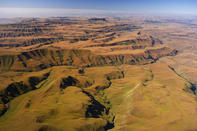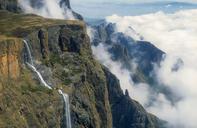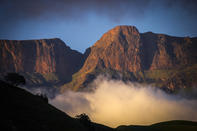Karoo Supergroup
The escarpment and high peaks are the capping on top of many horizontal layers of the Karoo Supergroup of rocks, which cover about two thirds of South Africa. The Drakensberg is made up of two distinct crowning layers: the Stormberg Group and volcanic basalt.

The Stormberg Group makes up the Little Berg and consists of three layers. The lowest are the Molteno Beds comprising mainly blue-grey sandstones that form terraces at the base of the Little Berg. Then come the Red Beds of red to purple mudstones and shales which form the grassy slopes. On top of this is the Clarens (or Cave) Sandstone layer which is soft and easily avoided and is where you’ll find the many caves of the Little Berg.
About 180 million years ago, when Gondwanaland began to split apart, huge fissures opened in the land and lava thrust to the surface, covering much of eastern South Africa. When the lava solidified, it formed the icing on the cake: the thick basalt layer that makes up the High Berg. Wind and water erosion have been doing their work ever since, creating the startling rock formations of these mountains.
Volcanic Flood

It is estimated that the supercontinent Gondwana split apart between 250 and 200 million years ago, just as the last of the Clarens Sandstone suite of rocks was being laid down. As the supercontinent broke up, however, the awesome power of the planet manifested, and a wide flood of volcanic basalt boiled up from the Mantle and swept across the land.
When this molten basalt had cooled, the Karoo Supergroup found itself riddled with subterranean intrusions, and much of South Africa was covered by a layer of solid rock up to 1400 meters deep. Inevitably, erosion started eating away at this vast swathe of flood-basalt almost as soon as it started to cool. Water ran off the summits and formed rivers, which cut steep valleys into the rock. Wind whipped at the stone and carried away the smallest fragments, piece by piece.
Most importantly, changes in temperature made the rock fault and crack, and this caused large boulders to dislodge and tumble down the mountain slopes, resting at the bottom until they were picked to pieces by the eternal forces of wind and water.
The Victoria Falls in Northern Zimbabwe is just one of the many natural water features that cut through this flood-basalt and carried away the pieces. Today, the sheer walls of the Drakensberg, the Lubombo Mountains in Swaziland and the Lesotho Highlands are the only mountainous remnants of this great volcanic flood. And, one day, they too will be gone.
Even the face of the mighty Natal Drakensberg is currently retreating at the stately pace of 1 cm every decade. John Keats was right; all beauty is transient.
Mountains of Basalt

One of the most significant events in the planet's geological past was when supercontinent Gondwana broke up and Africa drifted southwards. In the process, the Southern shore of Africa crumpled like a carpet someone had tripped on to form the Cape Folded Mountains, while inland the mantle cracked and quaked, and lava spewed out from the guts of the earth.
Some of it was forced in-between the many layers of rock underground where it formed iron-like dolerite dykes and sills which, where exposed, now constitute the Karoo koppies. The main act, however, was the biggest pyroclastic fireworks earth has ever seen: for two million years molten lava intermittently inured out and covered just about the whole of South Africa in an icing of pumice-like basalt up to 5 km thick in places.
Erosion has whittled away the soft rock, and now what we can see left of it makes up KwaZulu-Natal's Drakensberg escarpment and Lesotho's Highlands. But what a glorious escarpment it is.